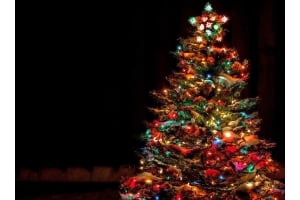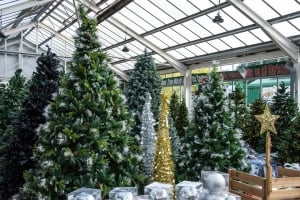Why Do We Have Christmas Trees and What Does the Christmas Tree Represent?
Bringing a tree into your home over the festive period is a long-standing tradition, whether you choose a real or artificial Christmas tree.
However, what does the Christmas tree that graces our home during this joyous season truly represent? In this guide, we’ll look into what the Christmas tree represents and what purpose Christmas trees have.
A brief history of Christmas trees
The history of Christmas trees may surprise you! Numerous legends surround its genesis. Both Protestant and Catholic religions claim to be the originators of the Christmas tree. However, many attribute it to old Pagan ceremonies.
The earliest recorded Christmas tree was in Germany during the Middle Ages and is associated with the Garden of Eden.
How did Christmas trees begin?
Historically, trees have been an integral feature of religious rites and used as ornaments. Egyptians worshipped Ra with fresh palm rushes. The early Romans used evergreens to adorn their temples in honour of their God, Saturn. And at the Winter Solstice, Pagans decorated the inside of their dwellings with evergreen branches.
The paradise tree connects the Christmas tree directly to the Christian creation account and the genesis of humanity. You might easily argue that the Christmas tree tradition dates back to the beginning of time and has grown via various religious activities and retellings of old legends.
Where did the first Christmas trees come from?
The contemporary Christmas tree can be traced back to Western Germany. A classic medieval performance about Adam and Eve had a paradise tree, a fir tree draped with apples that portrayed the Garden of Eden. On Christmas Eve, the Catholic feast day of Adam and Eve, the Germans set up a paradise tree in their houses.
They hung wafers from it, symbolising the Eucharistic host, the Christian emblem of salvation; subsequent traditions substituted the wafers with cookies of different forms. Candles were often added as a symbol of Christ as the light of the world.
There was a "Christmas pyramid”, a triangular wood structure with shelves for Christmas figurines and evergreens, candles, and a star in the same room. By the sixteenth century, the Christmas pyramid and paradise tree had combined to become the Christmas tree.
The Martin Luther story and the symbolisms of Christmas
According to Protestant mythology, German priest Martin Luther is credited with being the first to adorn a Christmas tree. Luther brought the significance and beauty of the evergreen into his house to inspire his wife and children during a long, gloomy winter.
He believed the evergreen symbolised God's eternal love and their own faith's endurance. The candles he used symbolised the star that led the Three Wise Men to Christ.
How did the Christmas tree come to the UK?
Queen Charlotte, the German wife of King George III, is credited with introducing the Christmas tree to the UK. She set up the first known Christmas tree in the UK at the Queen’s Lodge in Windsor as early as the 1790s.
What does the Christmas tree represent?
For many, the Christmas tree represents Jesus Christ's birth and resurrection. The tree branches and bushes are regarded as a sign of immortality and are thought to represent Christ's crown of thorns on the crucifixion.
Likewise, every item used to decorate the Christmas tree is believed to have a specific meaning. Though, individuals select Christmas tree decorations for decorating as per their desire.
The Christmas tree topper of choice is often a sparkling star. An angel is frequently used as a tree topper since it is thought to be the angel that heralded Christ's birth.
The symbolism of evergreen trees across cultures
Because evergreens keep their leaves throughout winter, they are generally seen as a sign of perpetual life and immortality. Symbolism related to evergreen trees may be found in various cultures. Many faiths also use trees as symbols, notably the Bible's Tree of Life.
Greek
The coniferous pine was considered holy by Attis, the Greek God of flora, or the realm of plants. In Greek custom, pine trees were adorned with silver, with bells and gifts put under the tree as offerings to the Gods.
Roman
In Roman culture, evergreen trees were regarded as sun symbols and were a symbol of light. They celebrated the Saturnalia celebration in honour of Saturn, the God of agriculture. Romans decked their houses and temples with evergreen boughs to commemorate the occasion.
German
Gold torcs and jewellery were adorned on fir and pine trees to pay homage to the goddesses of life and ensure a successful crop.
Chinese and Japanese
Pine and cypress trees are holy in Japanese and Chinese cultures and are connected with immortality and longevity. The wood from these trees is utilised to construct sacred constructions such as altars, temples and Shinto Kami complexes. Additionally, in these beliefs, pine and cypress are believed to contain the vital energy felt during the construction of these sacred monuments.
What do the different Christmas tree decorations represent?
Each Christmas tree ornament is thought to represent something meaningful. The ornaments will have additional significance once you know the importance and admire your decorated Christmas tree this year.
Christmas lights
Depending on your background, Christmas tree lights can signify the light of God's spirit, the value of enlightenment or wisdom, or the warmth of family love.
Today, people all across the globe participate in the age-old custom of decorating with Christmas tree lights.
Ornaments
According to some contemporary Christians, red Christmas baubles or ornaments on a Christmas tree are symbolic of Christ's blood or sacrifice.
Other decorations also hold certain meanings. For example, gold and silver represent the many gifts we receive in this life and green represents the life of trees and the blessings from nature.
Tree topper
Traditionally, a star or an angel is placed atop the Christmas tree. In the tale of Jesus' birth, both symbols are significant.
Ribbons and garlands
Ribbons and garlands may symbolise the links that bring family members together throughout the holidays.
Tinsel
Tinsel represents the sparks that ignited the fire built by Joseph to keep Mary and Jesus warm in the stable after Jesus' birth.
Candy canes
Candy canes are thought to symbolise the shepherd's stick, which he used to guide his flock of sheep, because of its shape and colour.
Christmas wreath
A Christmas wreath represents God's boundless love for humanity. Additionally, it means that authentic love has no beginning or end.
Pine cones on Christmas trees
On Christmas trees, pine cones often represent fertility and motherhood.
Follow Christmas tradition and find the perfect tree this festive season
The Christmas season will not be merry and bright without a Christmas tree and Christmas decorations! Find incredible artificial pine Christmas trees, Christmas lights and Christmas decorations with help from Christmas Tree World. Whether you’re looking for a pre-lit Christmas tree or a snowy Christmas tree, there is a Christmas tree to suit your aesthetic!








